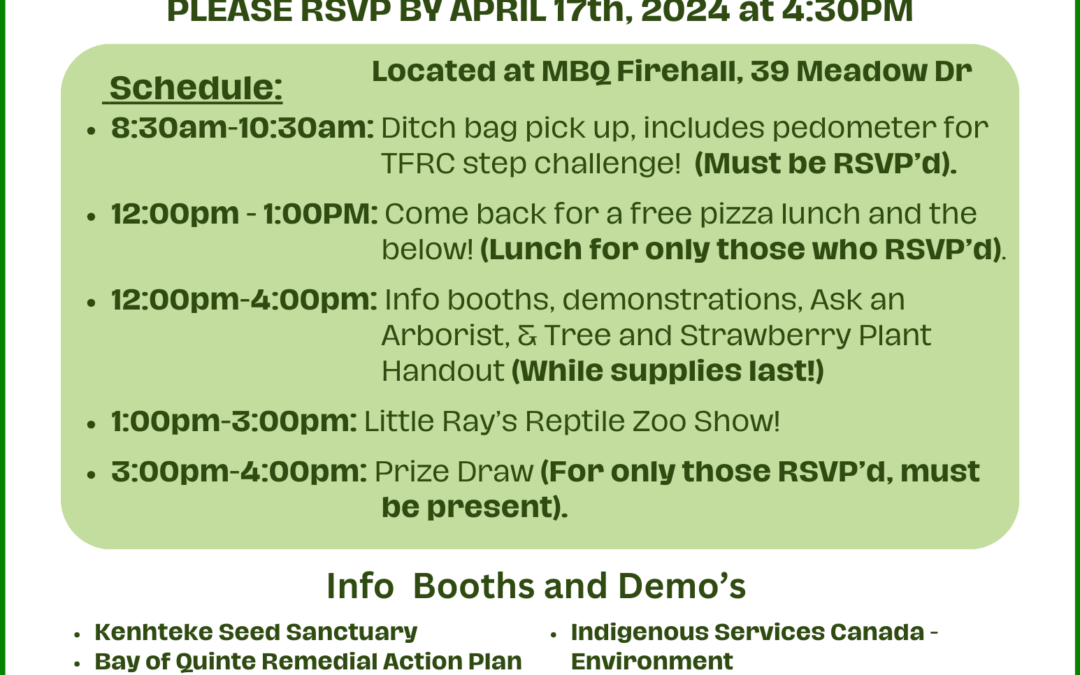ENVIRONMENTAL SERVICES
Tsi Niyoht Wenhtsya:ke (It is about the Environment/Earth)
Background
The Environment is a gift and it is our responsibility as caretakers to protect it. A healthy environment means healthy people. Honouring diversity, respecting creations’ life-cycle, embracing our interconnectedness to creation and practicing Kanyen’kenaka traditional beliefs and using the Ohen:ton Karihwate’hkwen as our guide are the foundation of a healthy and sustainable community for future generations.
Overview
The Environmental Unit is responsible for:
- Investigating environmental issues
- Completing environmental screenings and assessments
- Business registration environmental reviews
- Operating and managing waste and recycle curbside collection program
- Shoreline alterations
- Co-ordinating and managing annual Harvest Managers program
- Co-ordinating and managing annual Sea Lamprey program
- Promoting environmental public awareness and education
- Species at Risk inventory
- Proposal writing for environmental projects
- Earth Day activities
- Providing technical comments to on-reserve/Territory and off-Territory construction projects as required by the federal government’s Duty to Consult (First Nations)
- Serving as liaison to Department of Fisheries and Oceans, Environment Canada and the Mohawks of the Bay of Quinte
- Creating relationships with Ministry of Natural Resources, Ministry of the Environment, Quinte and Lower Trent Conservation Authorities
Programs & Services
Waste & Recycling
The Environment Department oversees waste and recycling on Tyendinaga Mohawk Territory. Household garbage (whether tagged or not) will NOT be accepted at the Transfer Depot – Large items, electronics, hazardous waste, motor oil, tires, cooking oil, metal, and fish remains ONLY.
Backyard Burning
The Environmental Services Co-ordinator provides information regarding the hidden hazards of backyard burning.
Shoreline Alterations
The Environmental Services Co-ordinator will work co-operatively with community members, the Mohawks of the Bay of Quinte and the Department of Fisheries and Oceans to ensure proposed projects that may impact fish habitat are designed and implemented in such a manner as to avoid a harmful alteration, disruption or destruction of fish habitat.
Harvest Managers
This program educates the community on proper walleye harvesting techniques, and trains them on how to milk the fish for conservation measures. This program helps to restore and promote the traditional methods of “milking” the fish and returning the fertilized “milt” to the spawning beds, to increase the sustainability of the walleye by educating and promoting the traditional techniques to harvesters. Harvest Managers are not hired for enforcement, but for conservation purposes.
Roadside Dumping
The Environment Department investigates roadside dumping and dumping on commonly held lands. Clean-up takes place to ensure the health and vitality of the community is upheld. Dumping on private lands are the responsibility of the home/land processor, who ensures the waste is taken to a proper facility.
Spills
The Environmental Services Co-ordinator is responsible for reporting and co-ordinating the clean-up and/or remediation of the contaminated area unless on privately held lands (CP held lands). The Environmental Services Co-ordinator is responsible for reporting, documenting and providing guidance on the clean-up and/or remediation of contaminated areas on privately held lands. “Contaminate” refers to any solid, liquid, gas, odour, heat, sound, vibration, radiation or combination of any of them, as a result of an individual, group or machinery that may directly or indirectly impair the natural environment, cause harm or discomfort to any person, cause injury or damage to property or to plant or animal life or habitat, adversely effect the health or impair the safety of any person, or render any property or plant life unfit for use by man. “Natural Environment” means the land, air and water or any combination or part thereof.
Species at Risk
We have 16+ possible Species at Risk on the Territory, ranging from shrubs, grasses and trees, to birds, turtles, snakes and butterflies. With continuing research we can locate more species in order to help protect them and their habitat.


